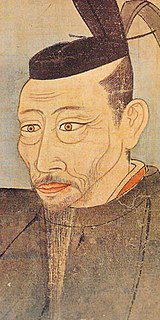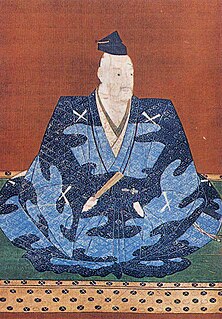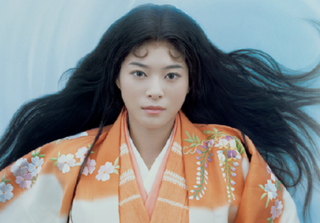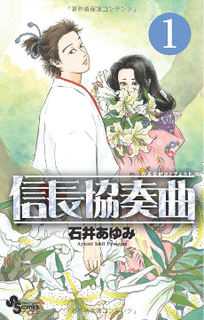
Endō Naotsune(遠藤 直経, 1531 – August 9, 1570) was an officer under the Azai clan who was known as a fierce warrior during the Sengoku period of the 16th century of Japan.

The Azai clan was a line of daimyōs during Japan's Sengoku period that was based in Ōmi Province. The Azai clan, along with the Asakura clan, opposed Oda Nobunaga in the late 16th century. They were defeated by him at the Battle of Anegawa in 1570, and all but eliminated when their home castle, Odani Castle, was taken three years later.
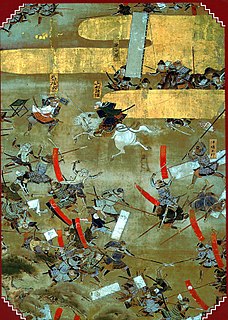
The Sengoku period is a period in Japanese history marked by social upheaval, political intrigue and near-constant military conflict. Japanese historians named it after the otherwise unrelated Warring States period in China. It was initiated by the Ōnin War, which collapsed the Japanese feudal system under the Ashikaga shogunate, and came to an end when the system was re-established under the Tokugawa shogunate by Tokugawa Ieyasu.

Japan is an island country in East Asia. Located in the Pacific Ocean, it lies off the eastern coast of the Asian continent and stretches from the Sea of Okhotsk in the north to the East China Sea and the Philippine Sea in the south.
Naotsune was opposed to the political marriage between his lord Azai Nagamasa and Oda Nobunaga's sister Oichi. During the Battle of Anegawa, Naotsune camouflaged his own men to resemble those of Nobunaga's, to infiltrate Nobunaga's army. Nobunaga became aware of Naotsune's intentions, and killed him.[ citation needed ]

Azai Nagamasa was a daimyō during the Sengoku period of Japan. His clan, the Azai clan, were located in northern Ōmi Province, east of Lake Biwa. He was the brother-in-law of Oda Nobunaga, starting in 1564, and one of Nobunaga's enemies from 1570 to 1573. Nagamasa and his clan were destroyed by Oda Nobunaga in August 1573. Major battles of Azai Nagamasa include the battle of Anegawa in 1570 and the many sieges of Odani castle between 1570 and 1573.

Oda Nobunaga was a powerful daimyō of Japan in the late 16th century who attempted to unify Japan during the late Sengoku period, and successfully gained control over most of Honshu. Nobunaga is regarded as one of three unifiers of Japan along with his retainers Toyotomi Hideyoshi and Tokugawa Ieyasu. During his later life, Nobunaga was widely known for most brutal suppression of determined opponents, eliminating those who by principle refused to cooperate or yield to his demands. His reign was noted for innovative military tactics, fostering free trade, and encouraging the start of the Momoyama historical art period. He was killed when his retainer Akechi Mitsuhide rebelled against him at Honnō-ji.

Oichi was a female historical figure in the late Sengoku period. She is known primarily as the mother of three daughters who married well – Yodo-dono, Ohatsu and Oeyo.
In 1569 he donated an illustrated poem to the Taga-taisha shrine, which still survives. [1]

Taga-taisha (多賀大社) is a Shinto shrine located in Taga, Shiga Prefecture, Japan dedicated to Izanagi and Izanami. It is associated with long life, successful marriage and good fortune. The shrine is frequently referred to as O-taga-san (お多賀さん) by local residents. The gardens of the inner shoin are a nationally designated Place of Scenic Beauty.
